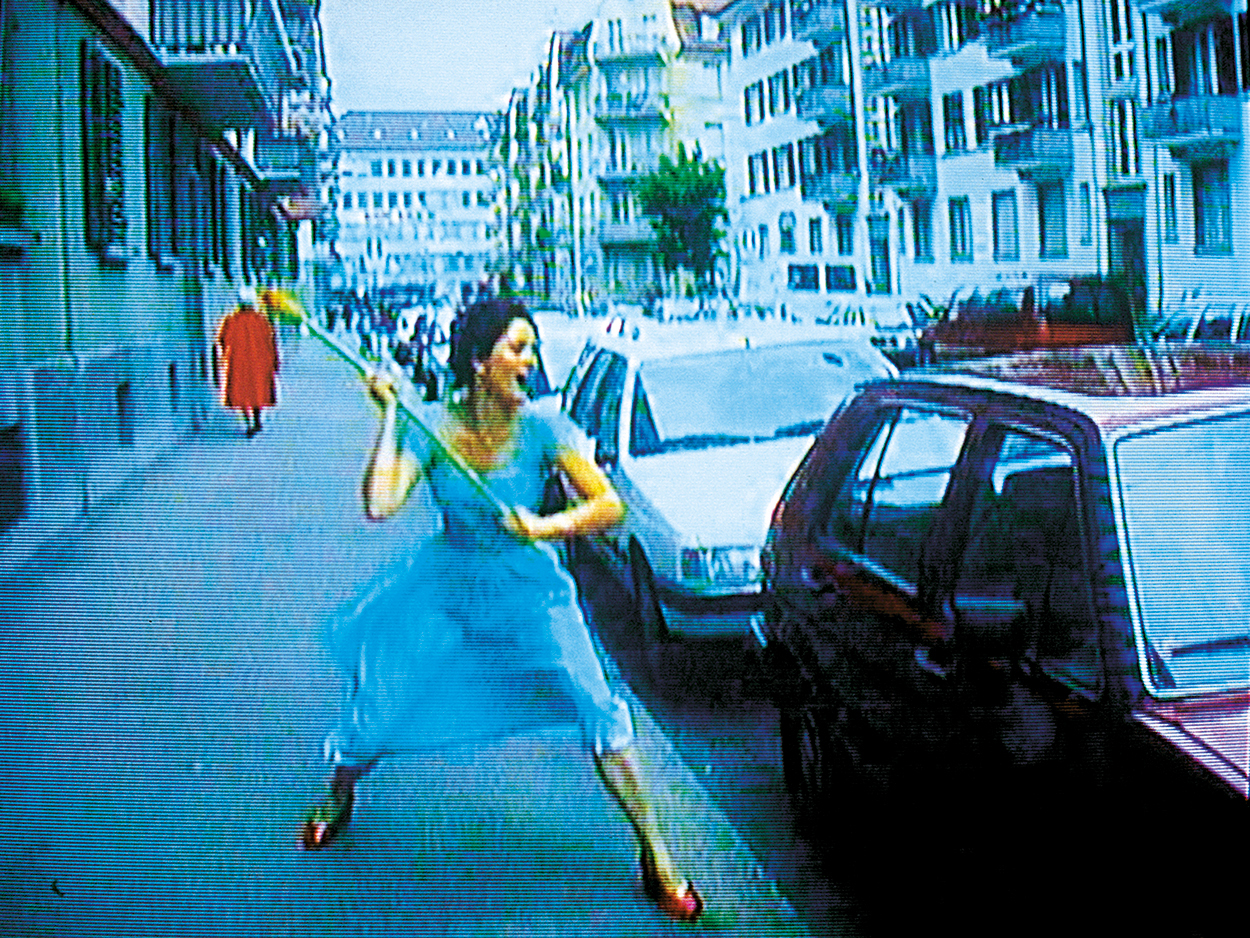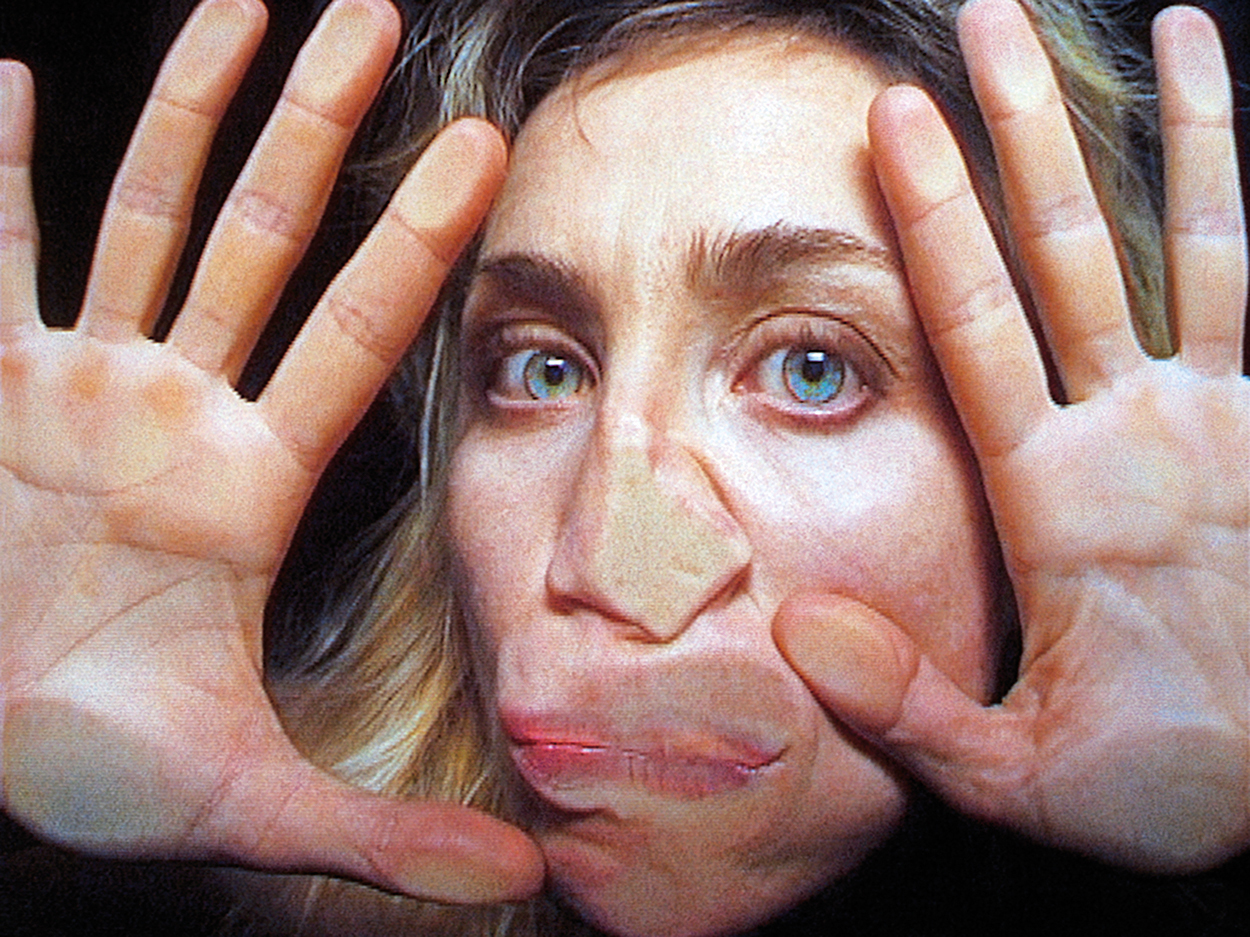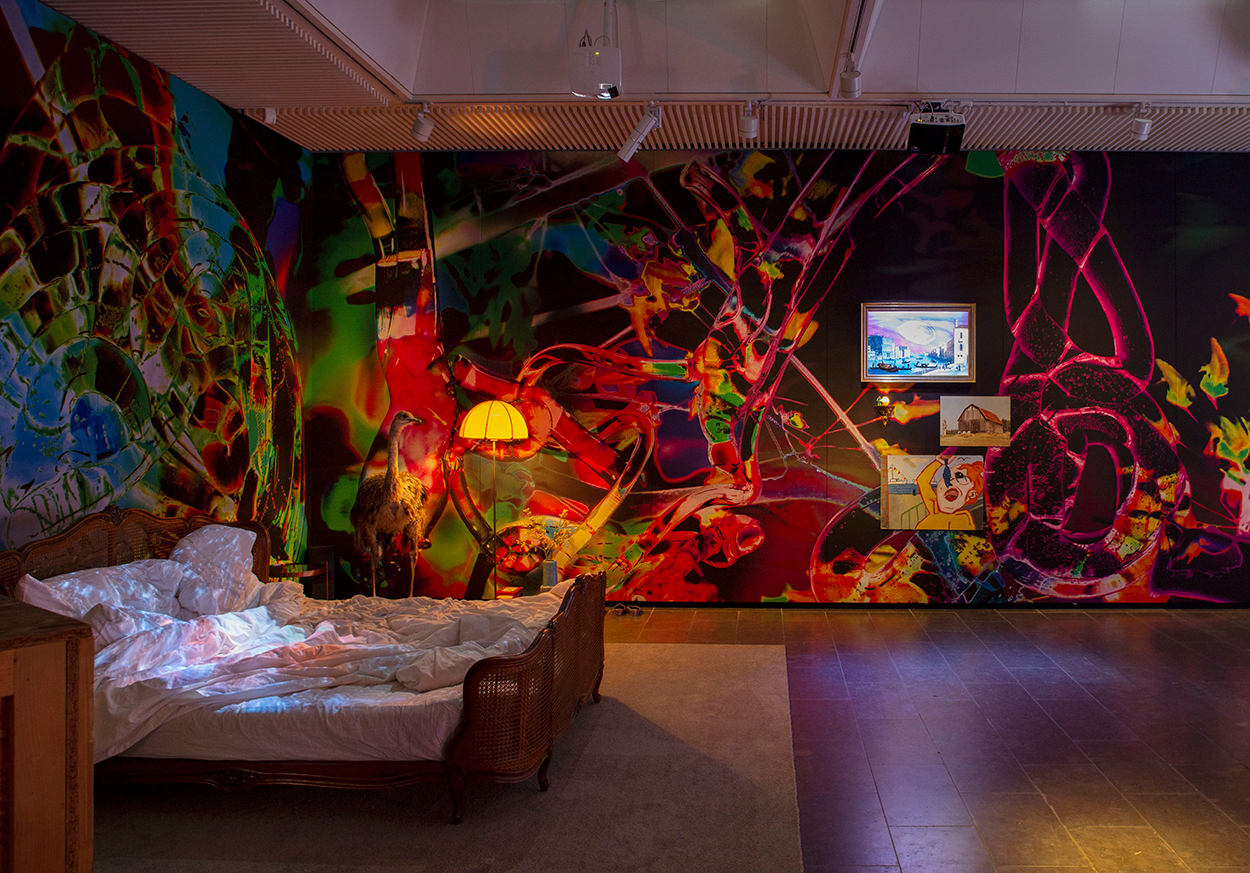 Still from Pipilotti Rist’s Neighbors Without Fences, 2021, video installation. © Pipilotti Rist. Courtesy of the artist, Hauser & Wirth, and Luhring Augustine
Still from Pipilotti Rist’s Neighbors Without Fences, 2021, video installation. © Pipilotti Rist. Courtesy of the artist, Hauser & Wirth, and Luhring Augustine
In her first year of art school, the Swiss artist Pipilotti Rist made a piece that would soon become a textbook example of feminist video art. Titled I’m Not the Girl Who Misses Much (1986), the glitchy seven-minute work—her first video ever—is washed in pink, then blue, and it shows Rist frantically dancing around, her breasts flopping out of her dress. She sings the titular line again and again, her voice pitched up quite high, in a riff on a lyric from the 1968 Beatles song “Happiness Is a Warm Gun.” After Rist showed the work in a few museums in the German-speaking world, three New York galleries reached out, and she soon signed on with Luhring Augustine—a big deal for a then-unknown video artist, since works made in the medium are so hard to sell. (Since then, she has also gotten representation with the mega-gallery Hauser & Wirth.) It was the first of many hits.
The Zurich-based artist’s popularity has continued to grow steadily ever since. Because her first major work resembled a music video and because she used to be in the Swiss pop band Les Reines Prochaines, some art historians have said she was influenced by MTV. But the artist denies having watched the channel in the ’80s. The reverse, though, is certainly true—Rist’s influence on music videos looms large today. The one for Beyoncé’s 2016 song “Hold Up” shows the singer skipping down a sidewalk in a flowing yellow dress, smashing car windows along the way using a baseball bat. Some members of the Beyhive instantly recognized it as an homage to Rist’s video Ever Is Over All (1997), in which the artist damages parked cars using an oversized fake flower while a policeman looks on approvingly. The same year Beyoncé’s song was released, Rist had a retrospective at the New Museum in New York that broke institutional attendance records, and her piece Open My Glade (Flatten), 2000, was screened across a series of jumbotrons in Times Square. It shows the artist looking silly with her face pressed up against glass.
 Still from Pipilotti Rist’s Ever Is Over All, 1997, video installation. © Pipilotti Rist. Courtesy the artist, Hauser & Wirth, and Luhring Augustine.
Still from Pipilotti Rist’s Ever Is Over All, 1997, video installation. © Pipilotti Rist. Courtesy the artist, Hauser & Wirth, and Luhring Augustine.
Rist is unusually popular for a video artist. (Three decades’ worth of her art is set to go on view in a show opening this Sunday at the Museum of Contemporary Art Los Angeles.) For that reason, some critics are skeptical. “I couldn’t forgive her videos for their inadvertent exposure of the female body as, yet again, an object of sexual desire,” reviewer Jane Cavalier wrote in 2016. Can Rist really have earned the “feminist” label she often wears? In other words, can she really challenge the status quo while also enjoying mainstream acceptance?
During the 1970s and ’80s, many video artists devoted their practice to issuing warnings against the spectacular qualities of the moving image. Dara Birnbaum’s famous Technology/Transformation: Wonder Woman (1978–79), for example, relied on appropriated footage from the series “Wonder Woman” to emphasize the troubling feminine stereotypes television often helps to normalize. It shows how TV begs to be uncritically ingested. By contrast, Rist delights in her medium’s potential for awe and wonder by making use of bright colors and soothing soundtracks. And why shouldn’t she? Video as a medium has often relied on women’s bodies to seduce the viewer, and Rist is out to change the terms. In other words, she sneaks her subversive messages about feminist pleasure right under your nose.
 Still fro Pipilotti Rist’s, Open My Glade (Flatten), 2000, single-channel video installation. © Pipilotti Rist. Courtesy the artist, Hauser & Wirth, and Luhring Augustine.
Still fro Pipilotti Rist’s, Open My Glade (Flatten), 2000, single-channel video installation. © Pipilotti Rist. Courtesy the artist, Hauser & Wirth, and Luhring Augustine.
In 1992, for example, Rist attempted to make a work of feminist porn. At the time, there was intense debate as to whether porn is inherently misogynistic. Miffed at the idea that dogma might dictate pleasure, Rist turned the discourse into a prompt. In the resulting single-channel Pickelporno (1992), a tiny camera traverses the surfaces of two bodies. “My theory with [Pickelporno] was that women—and I am not even sure you can really generalize that broadly—may be more interested in knowing what the other is feeling and thinking than in seeing the action as a third person from the outside,” she said in an interview included in the catalogue for her 2016 New Museum show. “When you watch sex from the outside, it is always much less interesting than when you are involved in it. So I wanted to make a porn film from the inside.”
Getting inside bodies has preoccupied Rist ever since, though her strategies for doing so continue to evolve. In her 1996 single-channel Mutaflor, she appears to swallow a tiny camera and then expel it from her anus—a trick she achieves by cutting to black between close-ups of her orifices. That same year, she created Sip My Ocean, her first immersive projection—the medium for which she would become best known. The rectangular screen had started to feel confined, and she wanted to break free. The footage, filmed largely underwater, is shown on two walls in a corner, with one channel mirroring the other to create a kaleidoscopic effect. In this and other alluring videos, she visually engulfs her viewers and lulls them with hypnotic soundtracks. She believes that “music and dancing are, in a way, reflections of the inner body” and that “we try to show our interior selves outside and melt together.”
 Still from Pipilotti Rist’s Selbstlos im Lavabad (Selfless In The Bath Of Lava), 1994, video installation. © Pipilotti Rist. Courtesy the artist, Hauser & Wirth, and Luhring Augustine.
Still from Pipilotti Rist’s Selbstlos im Lavabad (Selfless In The Bath Of Lava), 1994, video installation. © Pipilotti Rist. Courtesy the artist, Hauser & Wirth, and Luhring Augustine.
Periodically, these seductive, alluring works have generated controversy. Consider the case of Homo Sapiens Sapiens, which was installed in Venice’s San Stae Church in conjunction with the 2005 Biennale. The video, which drew huge crowds, shows a paradisiac world in which everyone is nude. Sometimes the imagery is sexually explicit, though the most memorable scenes feature ripe peaches being squeezed by hand until they burst or spooning couples seemingly afloat in space. All this is superimposed over lush dreamy landscapes and starry night skies. When Father Aldo Marangoni, the church’s priest, announced that the exhibition would close early, he cited technological problems, though many regarded his explanation with skepticism, since it came on the heels of a petition against nudity in churches that had made its way up to the pope himself.
Three years later, when Rist installed her immersive projection Pour Your Body Out in the vast second-floor atrium of the Museum of Modern Art in New York, a very different sort of protest ensued. Critic Jerry Saltz observed that during the show, “Mothers have been making playdates in the atrium, letting kids run around while they gather on the large round couch. Visitors bring computers and work here, or listen to iPods, or chat or doze or read.” Actress Alexandra Auder began holding yoga classes inside the installation in order to prevent viewers from being completely lulled into submission. She seems to have all but forgotten that Pour Your Body Out includes footage of a woman collecting her menstrual blood in a silver chalice. How radical it is to have such imagery become the backdrop for family affairs.
Rist’s work has long been dogged by accusations that it turns viewers passive. As if to one-up the naysayers, her 2016 installation 4th Floor to Mildness from the Mildness Family features a dozen or so beds below a video projected on the ceiling. The only way to watch the video is by lying down and gazing upward. It was the logical extension of Tu mich nicht nochmals verlassen (Do Not Abandon Me Again), 2015, in which colorful footage of a starry night is projected onto an inviting bed.
 View of the exhibition “Pipilotti Rist: Åbn min lysning (Open My Glade),” at the Louisiana Museum, Humlebæk, Denmark, 2019. Photo Poul Buchard. © Pipilotti Rist. Courtesy the artist, Hauser & Wirth, and Luhring Augustine.
View of the exhibition “Pipilotti Rist: Åbn min lysning (Open My Glade),” at the Louisiana Museum, Humlebæk, Denmark, 2019. Photo Poul Buchard. © Pipilotti Rist. Courtesy the artist, Hauser & Wirth, and Luhring Augustine.
Given the recurrent sexual imagery in Rist’s work, one would be forgiven for viewing these beds as a reference to intimacies of various kinds. This quasi-erotic content gets the most attention, but she’s also intent on divorcing shame from all kinds of everyday bodily functions. She encourages public napping, and menstruation regularly crops up in her work. In Blutclip (1993), a single-channel video shows fuchsia-colored menstrual blood dripping delicately down the artist’s body as a lively soundtrack plays.
When Rist started out, she nearly always trained the camera on herself, following a feminist tradition pioneered by Frederike Pezold, Joan Jonas, Dara Birnbaum, and Ulrike Rosenbach, all of whom used video to become both maker and muse. But Rist’s more recent works often involve a cast of actresses and a crew. These pieces are less glitchy, and often even more gorgeous. (Video technology has improved since the ’90s, and this has helped Rist refine her aesthetic.) She even made a feature film, Pepperminta (2009). It tells the story of a young girl who offers a sort of alchemical healing in the form of color. Shot entirely from low angles, as if filmed by a child, the work conveys an implicit feminist statement: women are often dismissed as being jejune in order to justify excluding them from positions of power. Color, too, has historically been considered “feminine,” unserious, distasteful, or superficial within art circles. With her vibrant videos, Rist is reclaiming a firmly feminine aesthetic.
Her use of projection has been described as feminine, too, by architecture historian Sylvia Lavin in her 2011 book Kissing Architecture. Lavin writes that Rist’s projections gently brush against rigid buildings in a feminine, flirtatious sort of way. But more recently, the artist also created permanent public artworks outdoors—yet another rare move for a video artist. Working with architect Carlos Martinez, she turned a square in the Swiss town of St. Gallen into a lounge with benches and fountains emerging from a poppy red street. Das Loft, a bar in Vienna, boasts a ceiling-sized screen showing one of her videos.
Rist has slowed down a bit in recent years after contracting hepatitis C. But she continues to push past limits of all kinds—the confines of the rectangular screen, moralizing dogmas, or even the anti-bright color bias some scholars call “chromophobia.” Critique her all you like. Just expect that she’ll take any objection as a challenge.
Source link : https://www.artnews.com/feature/pipilotti-rist-who-was-she-why-is-she-important-1234603482












